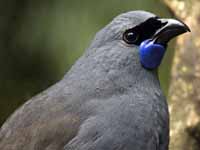The New Zealand wattlebirds are unrelated to the large Australian wattlebirds of the family Meliphagidae. They are ground-dwelling songbirds, 25–38 cm in length. They inhabit dense forests, where they feed on insects. These wattlebirds have strong legs and featherless wattles behind the bill. Their wings are rounded and unusually weak, giving them very limited powers of flight. They have no close relatives except the stitchbird.
Genus Callaeas - 1 species
Kokako,_North_Island Callaeas wilsoni
Description: The North Island kokako has grey plumage. It has a small black mask and blue wattles at the base of its black bill. It is best located by its beautiful organ-like song which only happens shortly after sunrise. The North Island kokako is up to 38 cm long. The South Island kokako from the South Island of New Zealand is now believed to be extinct.
Range: North Island of New Zealand.
Habitat: Forests, shrublands. Appears to be more habitat degradation tolerant than formerly thought.
Diet: Fruit, leaves, buds. Probably insects while breeding.
Conservation status: It is listed as Near Threatened because deforestation and introduced predators such as rats and stoats. Populations are being reintroduced to predator free islands.
Image by: 1) Matt Binns 2) Doug Mak - Mt Bruce Wildlife Centre, New Zealand 3) David Cook- Tiritiri Matangi Island, North Island,
New ZealandRange: North Island of New Zealand.
Habitat: Forests, shrublands. Appears to be more habitat degradation tolerant than formerly thought.
Diet: Fruit, leaves, buds. Probably insects while breeding.
Conservation status: It is listed as Near Threatened because deforestation and introduced predators such as rats and stoats. Populations are being reintroduced to predator free islands.



Genus Philesturnus
Saddleback,_North_Island Philesturnus rufusater
Description: The North Island saddleback has mainly black plumage. It has a chestnut "saddleback" band across the middle of its upperparts. The rump is also chestnut. There are orange-red wattles. The South Island saddleback is about 25 cm long.
Range: North Island of New Zealand.
Habitat: Lowland forests.
Diet: Insects, berries, invertebrates, nectar. They forage mostly in leaf litter.
Conservation status: It is listed as Near Threatened as at one time it eliminated from the mainland. There is a reintroduction program into areas with no or limited predators.
Range: North Island of New Zealand.
Habitat: Lowland forests.
Diet: Insects, berries, invertebrates, nectar. They forage mostly in leaf litter.
Conservation status: It is listed as Near Threatened as at one time it eliminated from the mainland. There is a reintroduction program into areas with no or limited predators.



Saddleback,_South_Island Philesturnus carunculatus
Description: The South Island saddleback has mainly black plumage. It has a chestnut "saddleback" band across the middle of its upperparts. The rump is also chestnut. There are orange-red wattles. The South Island saddleback is about 25 cm long.
Range: South Island of New Zealand.
Habitat: Scrub and coastal forest.
Diet: Insects, berries, invertebrates; also nectar.
Conservation status: It is listed as Near Threatened. All of the current populations are due to a reintroduction program into areas with no or limited predators.
Image by: 1) Bernard_Spragg - McLeans Island, Canterbury, South Island of New Zealand 2) Vil_SandiRange: South Island of New Zealand.
Habitat: Scrub and coastal forest.
Diet: Insects, berries, invertebrates; also nectar.
Conservation status: It is listed as Near Threatened. All of the current populations are due to a reintroduction program into areas with no or limited predators.


The only species in the Notiomystidae family is the Stitchbird. The Stitchbird or hihi is a rare honeyeater-like bird endemic to the North Island and adjacent offshore islands of New Zealand. It became extirpated everywhere except Little Barrier Island but has been reintroduced to three other island sanctuaries and two locations on the North Island mainland. Its evolutionary relationships have long puzzled ornithologists, but it is now classed as the only member of its own family, the Notiomystidae.
Genus Notiomystis
Stitchbird Notiomystis cincta
Description: The male stitchbird has black white and yellow upperparts. He has a black hood with white ear coverts. There is a yellow breast-band below the black hood. It has a long tongue which is used to gather nectar. The female is mainly grey, but has the same white pattern on her wings as does the male.
Range: Near North Island of New Zealand.
Habitat: Undisturbed forests.
Diet: Nectar, fruits, insects, spiders.
Conservation status: It is listed as Vulnerable as there are no more mainland birds because of introduced predators. Breeding programs helps sustain some populations on predator free islands, but there are problems due to inbreeding.
Range: Near North Island of New Zealand.
Habitat: Undisturbed forests.
Diet: Nectar, fruits, insects, spiders.
Conservation status: It is listed as Vulnerable as there are no more mainland birds because of introduced predators. Breeding programs helps sustain some populations on predator free islands, but there are problems due to inbreeding.



